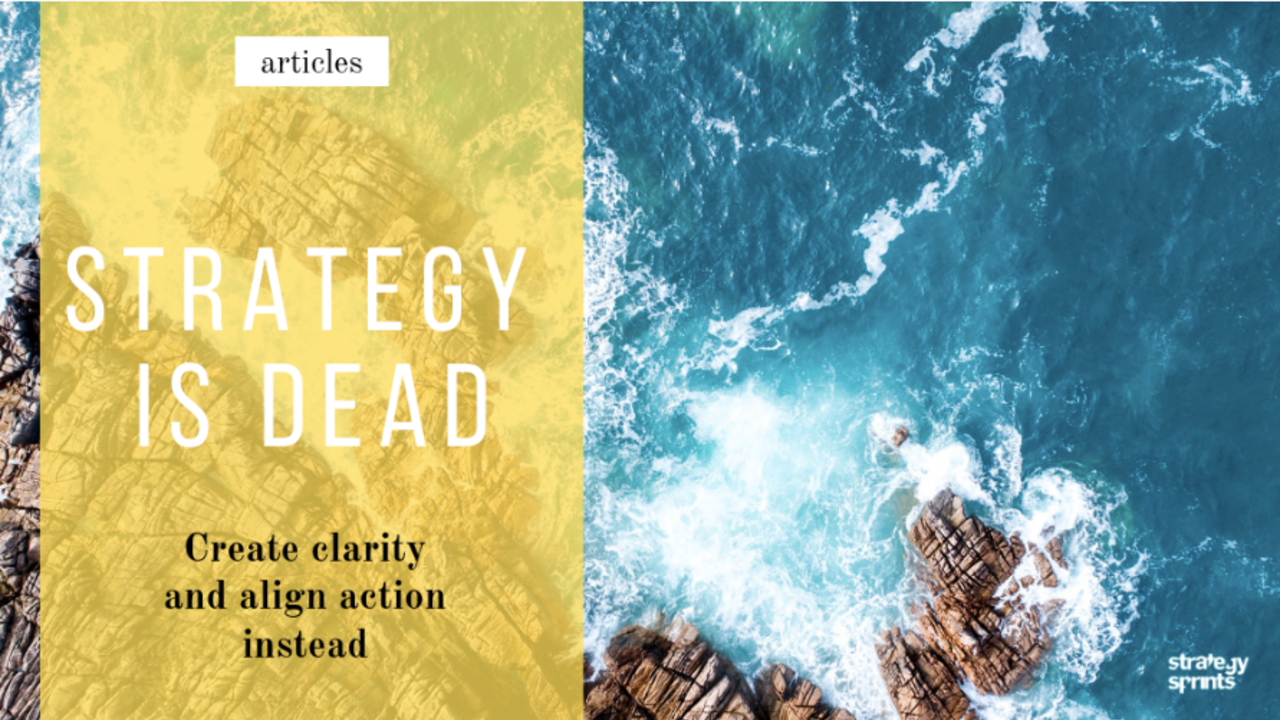
Strategy Is Dead.
Create clarity and aligned action instead.
Clarity and focus are often missed when you ask business owners “What do you create, and who is it for?”. It gets blurrier if you dig deeper asking which the current top projects are. Their teams struggle even more to explain why their daily activities matter, and what builds on what – in this current quarter. They’ll tell you great stories, until you both forget what the question was. During the last fifteen years I’ve been validating processes and tools to deliver a better way to strategize: real, simple and true.
Being an entrepreneur myself, I also constantly struggle to find clear and compelling words to shed a light on both what we do and why it matters. Just last week a sprinter from our tech department yelled in the sprint review: “Why should we accept this new project, Simon?! Show me how it fits in with our current strategy”. The following dialogue was important and clarifying. It could also have been tedious and energy-sucking like many strategy discussions I observed in over 1600 days of strategy sessions from New York to Beijing. To my surprise, a single tool we use, the clarity card, has been a catapult of clarity and impact for hundreds of entrepreneurs, executive teams and strategy teams we worked with. As usual, we are happy to share it with you, our community of sprinters, because every iteration and every comment makes our products sharper. So here is a full description of the four main strategy mistakes I observed over the years and the four steps we do in every planning session to regain clarity and keep rolling. We’ll do it Brecht style, first the summary, then the whole story.
EXECUTIVE SUMMARY
Why teams get stuck: Four strategy mistakes.1 Lack of clarity and direction.2 Too many projects at once.3 Tasks are not sharp enough.4 Spinning wheels.
How to keep rolling: Four practices to unstuck strategy teams. 1 Define the direction.2 Prioritize for impact.3 Clarify what builds on what.4 Decide ownership and actions.
Problem one: Lack of clarity and direction. Every single pain point is real and common. We face this ourselves and learned to get unstuck faster week by week. Our current state of error is to do a “planning session” for 30 minutes every three weeks and a “sprint review” of 30 minutes every week. This is exactly what we do in the planning session:

Solution one: Define the direction. Step one is to review if our direction is still the right one. We do this by double-checking that our long-term aspirations (Vision 3-5 Years) are really moved forward by the current top five projects of this year (1 Year). The dots indicate if every single project is – really – moving the needle forward in the right (our common) direction. This triggers meaningful team discussions and ensures we do not pursue vanity projects, activities that are trendy or fancy but do not really move our main aspirations forward. We think of strategy as a swim race, like the first part of a triathlon. In daily operations, our head mostly faces down, while the arms push forward. From time to time, we have to pull our head of the water, to see if we are still swimming in the right direction, and what is going on around us, weather, competitors, obstacles, impediments, surprises, chances. A quick look is enough, with the right tools. With the wrong ones, it can become a world of its own, like many so-called strategy meetings we all have seen around oval tables.
Problem two: Too many projects at once. Busyness over business is the name of the game. Everybody is sooo busy. Guess what? The people you really care about, don’t care about it. They want a more reliable solution to their current headache. Or a faster one, or a cheaper one. They do not care about your other activities. Thank goodness the Lean waves have brought a beneficial perspective on limiting the work in progress and increase flow.
Solution two: Our way is to limit our strategic priorities to exactly five. Not six, not seven. The image above is a screenshot from an actual session from our consulting work at Strategy Sprints GmbH.
Problem three: Tasks are not sharp enough. The missing link between having a plan and creating products or services people love is to do it. Even the most brilliant people we work with, struggle to get this done consistently. Imagine you want to encourage yourself to clean up your desk. Would you write down “Clean up desk”? A recipe for failure, too broad. Much more probable: “Decide which objects on my desk truly make me happy”, followed by “Move all others into the blue box in the garage”. As easy as it seems, it is hard for teams, unless they use some clarifying practices.

Solution three: Clarify what builds on what. Once asked how she manages to move so many things forward for her country, Angela Merkel replied in her calm and powerful style: “I take on big topics and slice them into small part, until they get manageable”. There is so much wisdom in this simple statement. Slicing the Elephant. That is what many agile methods currently help executive and product teams learn and apply. There are many methods to analyze what builds on what, like the Prioritization Start and many more, yet the most elegant and effective is to just allocate a dot where – after the team discussion – the activity really moves the overarching level forward.
Problem four: Spinning wheels. The meeting starts, slightly delayed, and the first item on the agenda says “Real Estate Strategy”… First ten minutes are used sharing information that everybody could have read upfront, then the tragic moment – A seemingly trivial question about which buildings are ready and which not degenerates to an infinity pool of perspectives added onto each other without anybody building on the ideas of others. Time’s up, frustration, see you next time, trying to smile, bye bye. Moderator pondering: “Where did I lose focus..?”. What started with the intention of clarifying the common path forward, became a halfhearted session that moved nothing forward.
Solution four: Decide on ownership and actions. Same meeting, different pattern: Start on time, surprising energizer, a giggling team facing one common big picture, the focus card. After five intense minutes re-agreeing on the long-term, one proposal after the other is being written down, in real-time, by someone who cares. With the dedication of a parent cooking a family dinner, every word counts and becomes an activity, visible to everyone, tacitly allowed to become more and more material. Ideas build on ideas and every clarification round makes them an increment. A small increment of the whole thing. A slice of an elephant. A contribution, to the parts, but to the whole thing. Something every team member can be proud of. Something they will tell later at the respective dinner tables with a soft, powerful glow of skin and eyes. Something that can ripple forward, maybe even to their kids, friends, and pets. A small difference that can make a huge difference is to decide at the right moment who will move this forward, and then close at the right moment. Bert Hellinger used to interrupt someone in the very middle of a sentence, the exact moment the solution had taken form. It was an act of love, interpreted as rudeness. This made him awkward and irritating, as well as memorable and a great teacher. When moderating group discussions, Peter Hawkins taught many systemic consultants like me to interrupt the group while their are loudly engaged, long before they would stop themselves. Angry participants would yell at him, as he mildly adds “You will enjoy the break much more”. Having said that, let’s recap the four main mistakes and four possible solution steps:
THE BIG WRAP UP
Why teams get stuck: Four strategy mistakes.
1 Lack of clarity and direction.
2 Too many projects at once.
3 Tasks are not sharp enough.
4 Spinning wheels.
How to keep rolling: Four practices to unstuck strategy teams.
1 Define the direction.
2 Prioritize for impact.
3 Clarify what builds on what.
4 Decide ownership and actions.
Keep rolling!
Simon
Get our expert sales tips delivered
By submitting you agree to receive our weekly Strategy Sprints Newsletter as well as other promotional emails from Strategy Sprints. You may withdraw your consent at any time via the “Unsubscribe” link in any email or view our privacy policy at ant time.










